Critical Reflection: Nursing Practice, Ethics, and Patient Care
VerifiedAdded on 2022/09/22
|8
|2185
|25
Essay
AI Summary
This essay presents a critical reflection on a nursing scenario involving a patient with pneumonia and a brain injury who wandered from the hospital due to inadequate supervision. The student nurse utilizes the Driscoll model to analyze the ethical and legal complexities of the situation, including violations of patient autonomy, beneficence, and non-maleficence. The reflection highlights the importance of informed consent, patient-centered care, and effective communication with families, referencing ethical guidelines from the ICN and NSQHS standards. The essay identifies areas for improvement in nursing practice, emphasizing the need for ethical awareness, therapeutic relationships, and the application of learned principles to ensure patient safety and quality care in future practice. The conclusion stresses the significance of ongoing education and training in ethical and legal requirements for nurses.
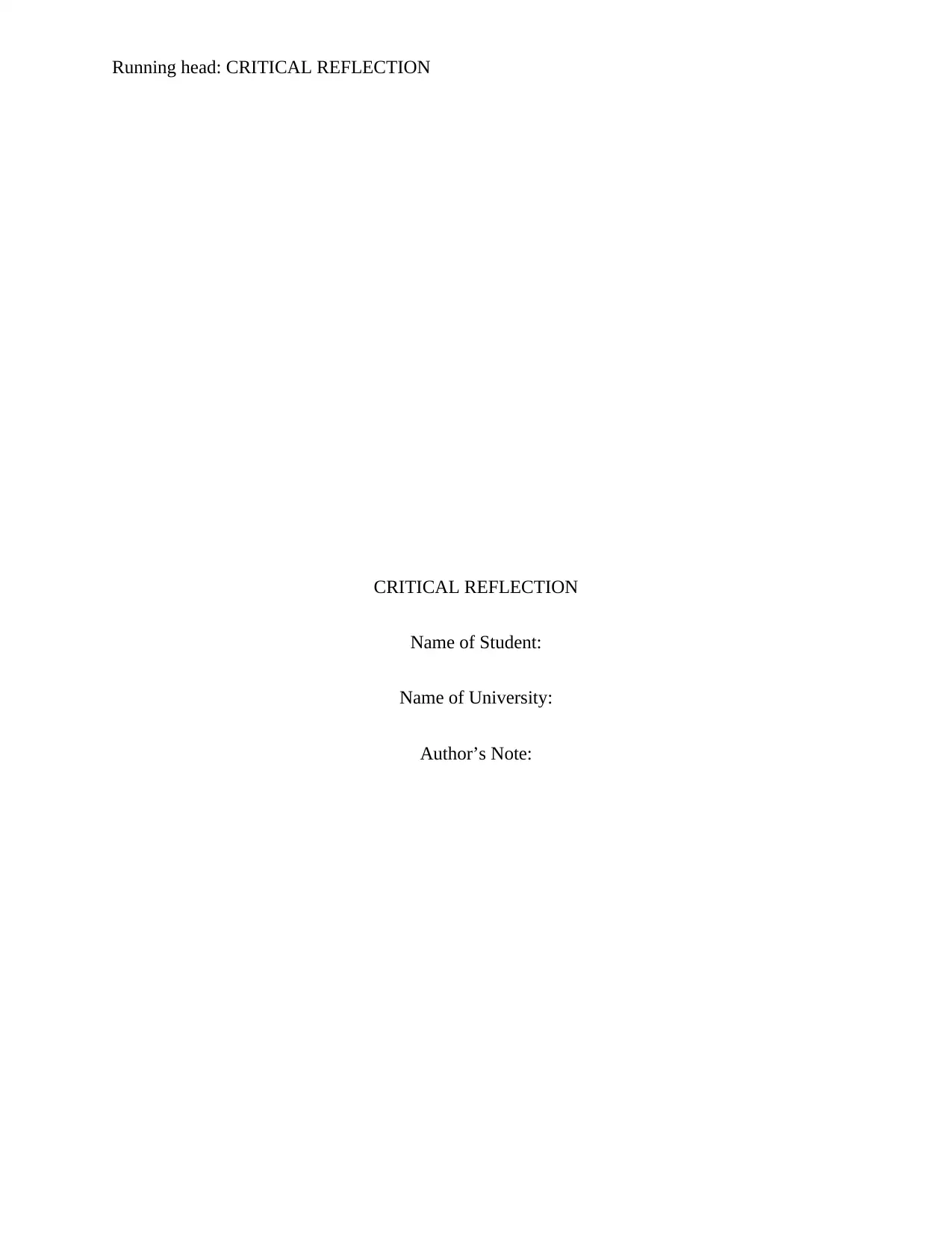
Running head: CRITICAL REFLECTION
CRITICAL REFLECTION
Name of Student:
Name of University:
Author’s Note:
CRITICAL REFLECTION
Name of Student:
Name of University:
Author’s Note:
Paraphrase This Document
Need a fresh take? Get an instant paraphrase of this document with our AI Paraphraser
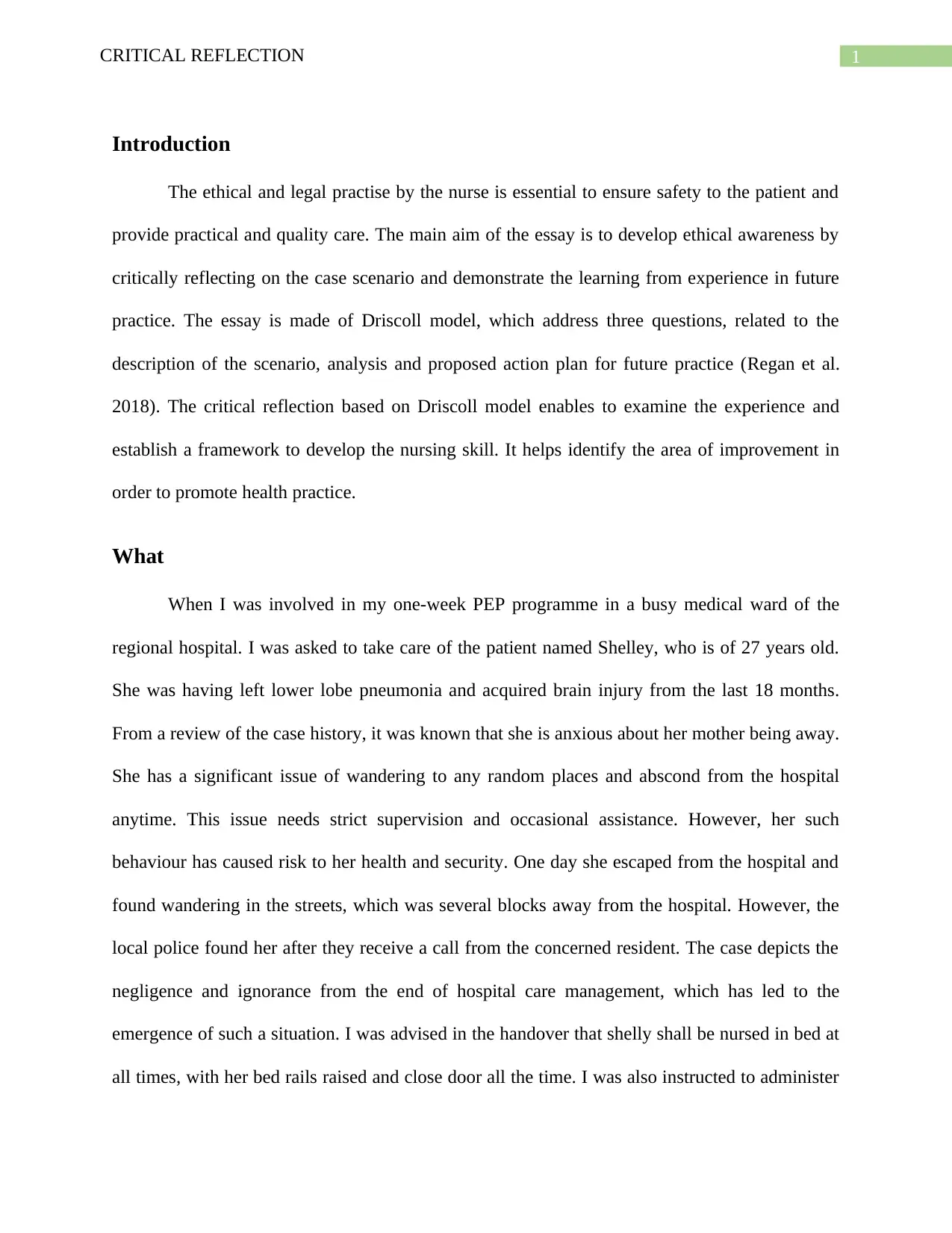
1CRITICAL REFLECTION
Introduction
The ethical and legal practise by the nurse is essential to ensure safety to the patient and
provide practical and quality care. The main aim of the essay is to develop ethical awareness by
critically reflecting on the case scenario and demonstrate the learning from experience in future
practice. The essay is made of Driscoll model, which address three questions, related to the
description of the scenario, analysis and proposed action plan for future practice (Regan et al.
2018). The critical reflection based on Driscoll model enables to examine the experience and
establish a framework to develop the nursing skill. It helps identify the area of improvement in
order to promote health practice.
What
When I was involved in my one-week PEP programme in a busy medical ward of the
regional hospital. I was asked to take care of the patient named Shelley, who is of 27 years old.
She was having left lower lobe pneumonia and acquired brain injury from the last 18 months.
From a review of the case history, it was known that she is anxious about her mother being away.
She has a significant issue of wandering to any random places and abscond from the hospital
anytime. This issue needs strict supervision and occasional assistance. However, her such
behaviour has caused risk to her health and security. One day she escaped from the hospital and
found wandering in the streets, which was several blocks away from the hospital. However, the
local police found her after they receive a call from the concerned resident. The case depicts the
negligence and ignorance from the end of hospital care management, which has led to the
emergence of such a situation. I was advised in the handover that shelly shall be nursed in bed at
all times, with her bed rails raised and close door all the time. I was also instructed to administer
Introduction
The ethical and legal practise by the nurse is essential to ensure safety to the patient and
provide practical and quality care. The main aim of the essay is to develop ethical awareness by
critically reflecting on the case scenario and demonstrate the learning from experience in future
practice. The essay is made of Driscoll model, which address three questions, related to the
description of the scenario, analysis and proposed action plan for future practice (Regan et al.
2018). The critical reflection based on Driscoll model enables to examine the experience and
establish a framework to develop the nursing skill. It helps identify the area of improvement in
order to promote health practice.
What
When I was involved in my one-week PEP programme in a busy medical ward of the
regional hospital. I was asked to take care of the patient named Shelley, who is of 27 years old.
She was having left lower lobe pneumonia and acquired brain injury from the last 18 months.
From a review of the case history, it was known that she is anxious about her mother being away.
She has a significant issue of wandering to any random places and abscond from the hospital
anytime. This issue needs strict supervision and occasional assistance. However, her such
behaviour has caused risk to her health and security. One day she escaped from the hospital and
found wandering in the streets, which was several blocks away from the hospital. However, the
local police found her after they receive a call from the concerned resident. The case depicts the
negligence and ignorance from the end of hospital care management, which has led to the
emergence of such a situation. I was advised in the handover that shelly shall be nursed in bed at
all times, with her bed rails raised and close door all the time. I was also instructed to administer
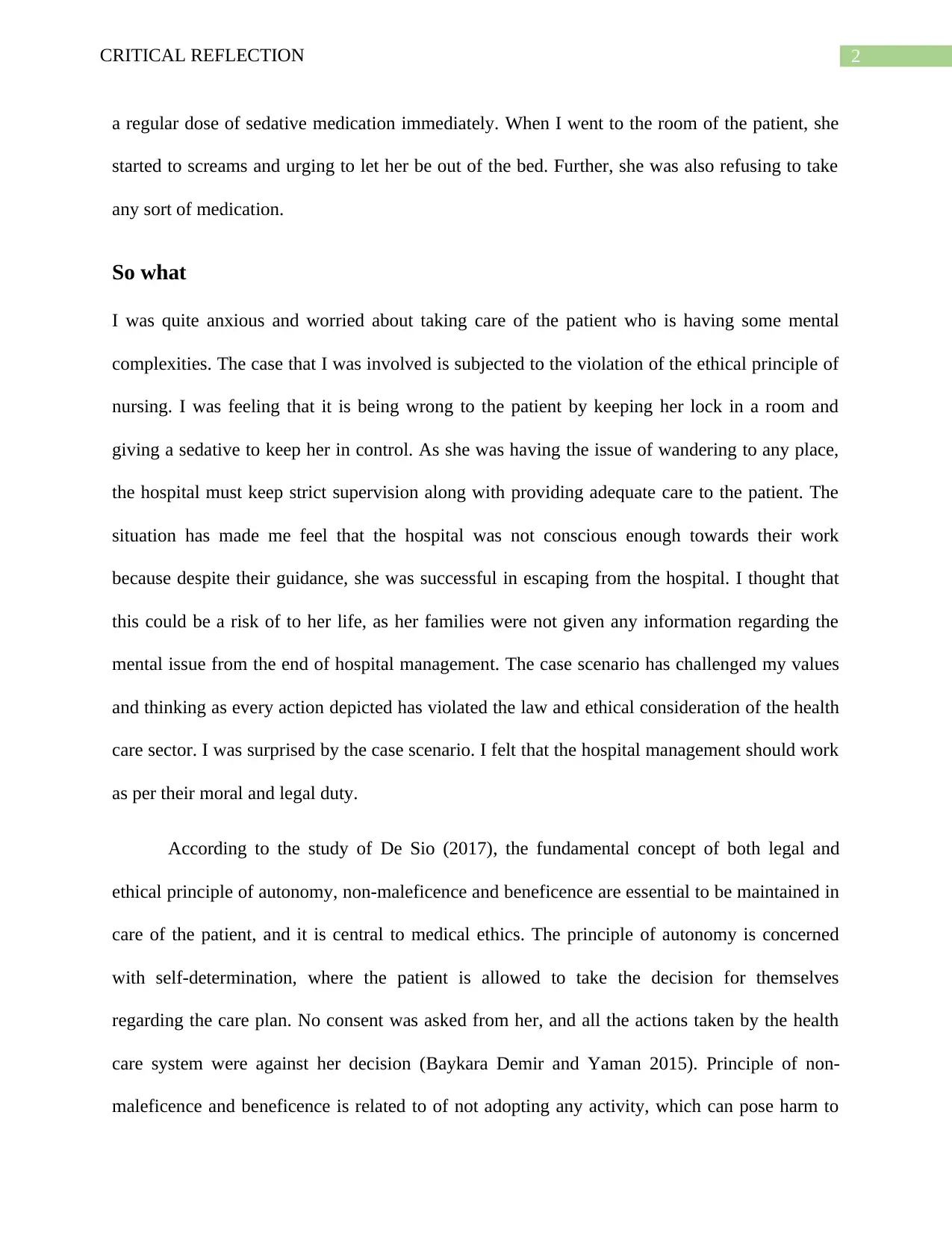
2CRITICAL REFLECTION
a regular dose of sedative medication immediately. When I went to the room of the patient, she
started to screams and urging to let her be out of the bed. Further, she was also refusing to take
any sort of medication.
So what
I was quite anxious and worried about taking care of the patient who is having some mental
complexities. The case that I was involved is subjected to the violation of the ethical principle of
nursing. I was feeling that it is being wrong to the patient by keeping her lock in a room and
giving a sedative to keep her in control. As she was having the issue of wandering to any place,
the hospital must keep strict supervision along with providing adequate care to the patient. The
situation has made me feel that the hospital was not conscious enough towards their work
because despite their guidance, she was successful in escaping from the hospital. I thought that
this could be a risk of to her life, as her families were not given any information regarding the
mental issue from the end of hospital management. The case scenario has challenged my values
and thinking as every action depicted has violated the law and ethical consideration of the health
care sector. I was surprised by the case scenario. I felt that the hospital management should work
as per their moral and legal duty.
According to the study of De Sio (2017), the fundamental concept of both legal and
ethical principle of autonomy, non-maleficence and beneficence are essential to be maintained in
care of the patient, and it is central to medical ethics. The principle of autonomy is concerned
with self-determination, where the patient is allowed to take the decision for themselves
regarding the care plan. No consent was asked from her, and all the actions taken by the health
care system were against her decision (Baykara Demir and Yaman 2015). Principle of non-
maleficence and beneficence is related to of not adopting any activity, which can pose harm to
a regular dose of sedative medication immediately. When I went to the room of the patient, she
started to screams and urging to let her be out of the bed. Further, she was also refusing to take
any sort of medication.
So what
I was quite anxious and worried about taking care of the patient who is having some mental
complexities. The case that I was involved is subjected to the violation of the ethical principle of
nursing. I was feeling that it is being wrong to the patient by keeping her lock in a room and
giving a sedative to keep her in control. As she was having the issue of wandering to any place,
the hospital must keep strict supervision along with providing adequate care to the patient. The
situation has made me feel that the hospital was not conscious enough towards their work
because despite their guidance, she was successful in escaping from the hospital. I thought that
this could be a risk of to her life, as her families were not given any information regarding the
mental issue from the end of hospital management. The case scenario has challenged my values
and thinking as every action depicted has violated the law and ethical consideration of the health
care sector. I was surprised by the case scenario. I felt that the hospital management should work
as per their moral and legal duty.
According to the study of De Sio (2017), the fundamental concept of both legal and
ethical principle of autonomy, non-maleficence and beneficence are essential to be maintained in
care of the patient, and it is central to medical ethics. The principle of autonomy is concerned
with self-determination, where the patient is allowed to take the decision for themselves
regarding the care plan. No consent was asked from her, and all the actions taken by the health
care system were against her decision (Baykara Demir and Yaman 2015). Principle of non-
maleficence and beneficence is related to of not adopting any activity, which can pose harm to
⊘ This is a preview!⊘
Do you want full access?
Subscribe today to unlock all pages.

Trusted by 1+ million students worldwide
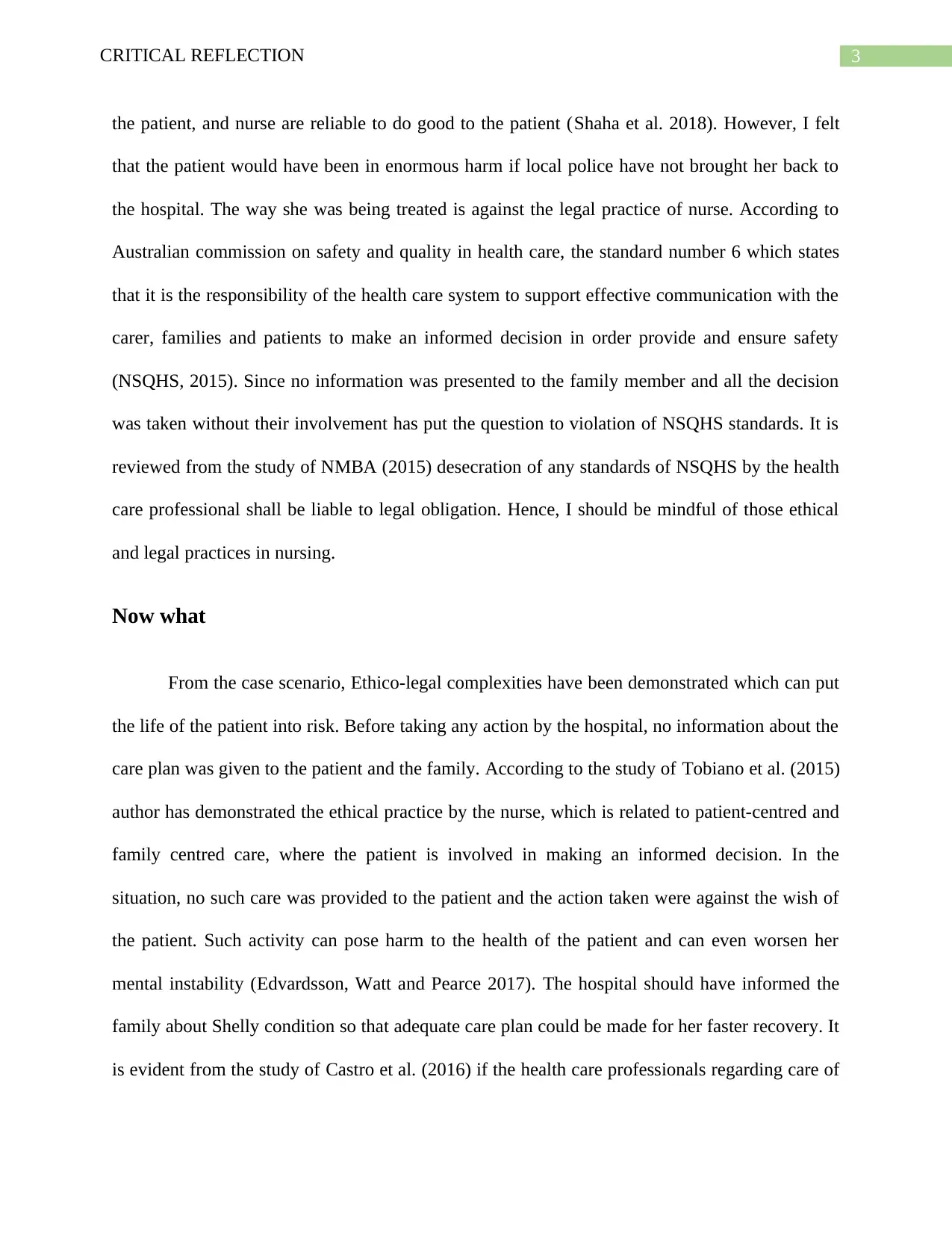
3CRITICAL REFLECTION
the patient, and nurse are reliable to do good to the patient (Shaha et al. 2018). However, I felt
that the patient would have been in enormous harm if local police have not brought her back to
the hospital. The way she was being treated is against the legal practice of nurse. According to
Australian commission on safety and quality in health care, the standard number 6 which states
that it is the responsibility of the health care system to support effective communication with the
carer, families and patients to make an informed decision in order provide and ensure safety
(NSQHS, 2015). Since no information was presented to the family member and all the decision
was taken without their involvement has put the question to violation of NSQHS standards. It is
reviewed from the study of NMBA (2015) desecration of any standards of NSQHS by the health
care professional shall be liable to legal obligation. Hence, I should be mindful of those ethical
and legal practices in nursing.
Now what
From the case scenario, Ethico-legal complexities have been demonstrated which can put
the life of the patient into risk. Before taking any action by the hospital, no information about the
care plan was given to the patient and the family. According to the study of Tobiano et al. (2015)
author has demonstrated the ethical practice by the nurse, which is related to patient-centred and
family centred care, where the patient is involved in making an informed decision. In the
situation, no such care was provided to the patient and the action taken were against the wish of
the patient. Such activity can pose harm to the health of the patient and can even worsen her
mental instability (Edvardsson, Watt and Pearce 2017). The hospital should have informed the
family about Shelly condition so that adequate care plan could be made for her faster recovery. It
is evident from the study of Castro et al. (2016) if the health care professionals regarding care of
the patient, and nurse are reliable to do good to the patient (Shaha et al. 2018). However, I felt
that the patient would have been in enormous harm if local police have not brought her back to
the hospital. The way she was being treated is against the legal practice of nurse. According to
Australian commission on safety and quality in health care, the standard number 6 which states
that it is the responsibility of the health care system to support effective communication with the
carer, families and patients to make an informed decision in order provide and ensure safety
(NSQHS, 2015). Since no information was presented to the family member and all the decision
was taken without their involvement has put the question to violation of NSQHS standards. It is
reviewed from the study of NMBA (2015) desecration of any standards of NSQHS by the health
care professional shall be liable to legal obligation. Hence, I should be mindful of those ethical
and legal practices in nursing.
Now what
From the case scenario, Ethico-legal complexities have been demonstrated which can put
the life of the patient into risk. Before taking any action by the hospital, no information about the
care plan was given to the patient and the family. According to the study of Tobiano et al. (2015)
author has demonstrated the ethical practice by the nurse, which is related to patient-centred and
family centred care, where the patient is involved in making an informed decision. In the
situation, no such care was provided to the patient and the action taken were against the wish of
the patient. Such activity can pose harm to the health of the patient and can even worsen her
mental instability (Edvardsson, Watt and Pearce 2017). The hospital should have informed the
family about Shelly condition so that adequate care plan could be made for her faster recovery. It
is evident from the study of Castro et al. (2016) if the health care professionals regarding care of
Paraphrase This Document
Need a fresh take? Get an instant paraphrase of this document with our AI Paraphraser
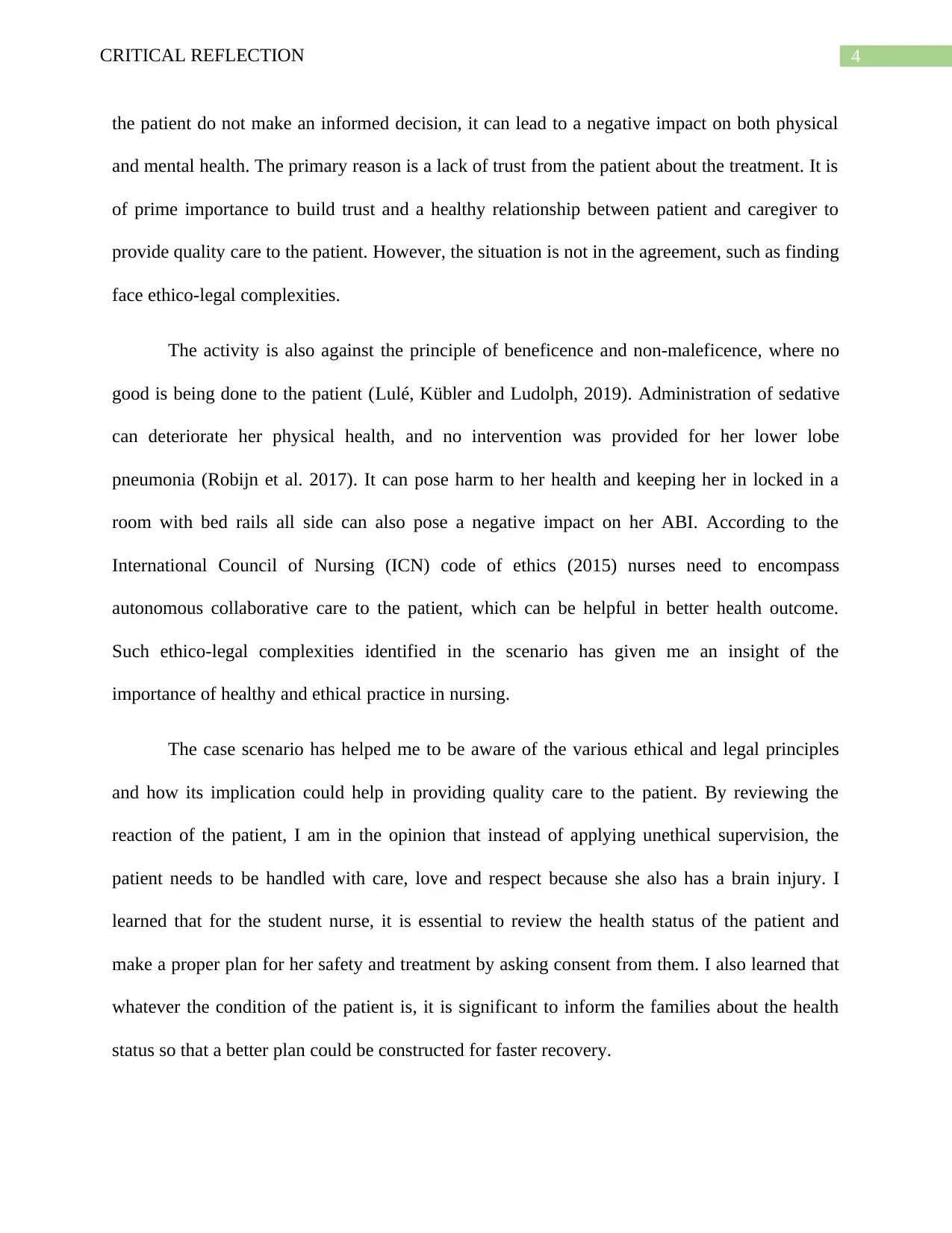
4CRITICAL REFLECTION
the patient do not make an informed decision, it can lead to a negative impact on both physical
and mental health. The primary reason is a lack of trust from the patient about the treatment. It is
of prime importance to build trust and a healthy relationship between patient and caregiver to
provide quality care to the patient. However, the situation is not in the agreement, such as finding
face ethico-legal complexities.
The activity is also against the principle of beneficence and non-maleficence, where no
good is being done to the patient (Lulé, Kübler and Ludolph, 2019). Administration of sedative
can deteriorate her physical health, and no intervention was provided for her lower lobe
pneumonia (Robijn et al. 2017). It can pose harm to her health and keeping her in locked in a
room with bed rails all side can also pose a negative impact on her ABI. According to the
International Council of Nursing (ICN) code of ethics (2015) nurses need to encompass
autonomous collaborative care to the patient, which can be helpful in better health outcome.
Such ethico-legal complexities identified in the scenario has given me an insight of the
importance of healthy and ethical practice in nursing.
The case scenario has helped me to be aware of the various ethical and legal principles
and how its implication could help in providing quality care to the patient. By reviewing the
reaction of the patient, I am in the opinion that instead of applying unethical supervision, the
patient needs to be handled with care, love and respect because she also has a brain injury. I
learned that for the student nurse, it is essential to review the health status of the patient and
make a proper plan for her safety and treatment by asking consent from them. I also learned that
whatever the condition of the patient is, it is significant to inform the families about the health
status so that a better plan could be constructed for faster recovery.
the patient do not make an informed decision, it can lead to a negative impact on both physical
and mental health. The primary reason is a lack of trust from the patient about the treatment. It is
of prime importance to build trust and a healthy relationship between patient and caregiver to
provide quality care to the patient. However, the situation is not in the agreement, such as finding
face ethico-legal complexities.
The activity is also against the principle of beneficence and non-maleficence, where no
good is being done to the patient (Lulé, Kübler and Ludolph, 2019). Administration of sedative
can deteriorate her physical health, and no intervention was provided for her lower lobe
pneumonia (Robijn et al. 2017). It can pose harm to her health and keeping her in locked in a
room with bed rails all side can also pose a negative impact on her ABI. According to the
International Council of Nursing (ICN) code of ethics (2015) nurses need to encompass
autonomous collaborative care to the patient, which can be helpful in better health outcome.
Such ethico-legal complexities identified in the scenario has given me an insight of the
importance of healthy and ethical practice in nursing.
The case scenario has helped me to be aware of the various ethical and legal principles
and how its implication could help in providing quality care to the patient. By reviewing the
reaction of the patient, I am in the opinion that instead of applying unethical supervision, the
patient needs to be handled with care, love and respect because she also has a brain injury. I
learned that for the student nurse, it is essential to review the health status of the patient and
make a proper plan for her safety and treatment by asking consent from them. I also learned that
whatever the condition of the patient is, it is significant to inform the families about the health
status so that a better plan could be constructed for faster recovery.
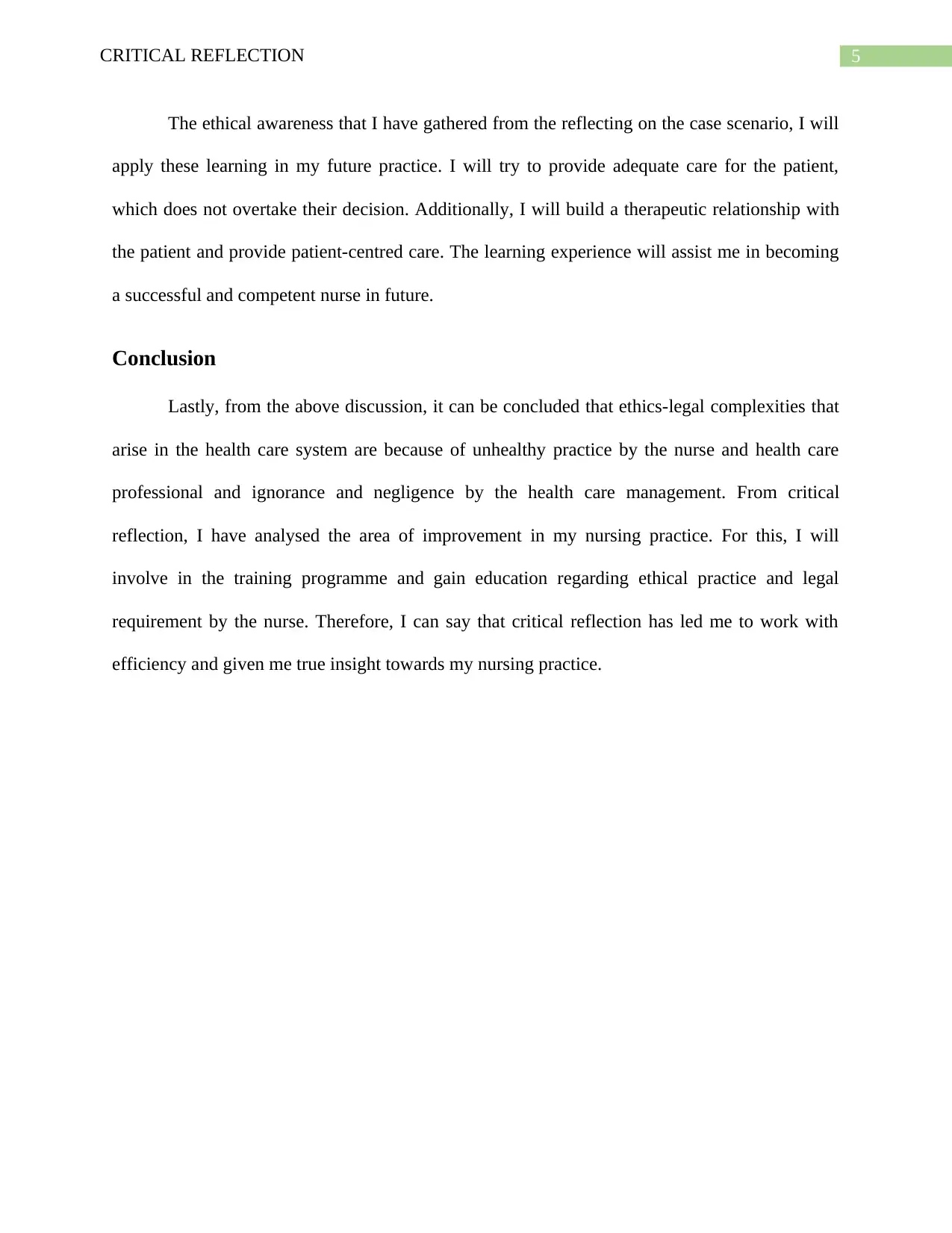
5CRITICAL REFLECTION
The ethical awareness that I have gathered from the reflecting on the case scenario, I will
apply these learning in my future practice. I will try to provide adequate care for the patient,
which does not overtake their decision. Additionally, I will build a therapeutic relationship with
the patient and provide patient-centred care. The learning experience will assist me in becoming
a successful and competent nurse in future.
Conclusion
Lastly, from the above discussion, it can be concluded that ethics-legal complexities that
arise in the health care system are because of unhealthy practice by the nurse and health care
professional and ignorance and negligence by the health care management. From critical
reflection, I have analysed the area of improvement in my nursing practice. For this, I will
involve in the training programme and gain education regarding ethical practice and legal
requirement by the nurse. Therefore, I can say that critical reflection has led me to work with
efficiency and given me true insight towards my nursing practice.
The ethical awareness that I have gathered from the reflecting on the case scenario, I will
apply these learning in my future practice. I will try to provide adequate care for the patient,
which does not overtake their decision. Additionally, I will build a therapeutic relationship with
the patient and provide patient-centred care. The learning experience will assist me in becoming
a successful and competent nurse in future.
Conclusion
Lastly, from the above discussion, it can be concluded that ethics-legal complexities that
arise in the health care system are because of unhealthy practice by the nurse and health care
professional and ignorance and negligence by the health care management. From critical
reflection, I have analysed the area of improvement in my nursing practice. For this, I will
involve in the training programme and gain education regarding ethical practice and legal
requirement by the nurse. Therefore, I can say that critical reflection has led me to work with
efficiency and given me true insight towards my nursing practice.
⊘ This is a preview!⊘
Do you want full access?
Subscribe today to unlock all pages.

Trusted by 1+ million students worldwide
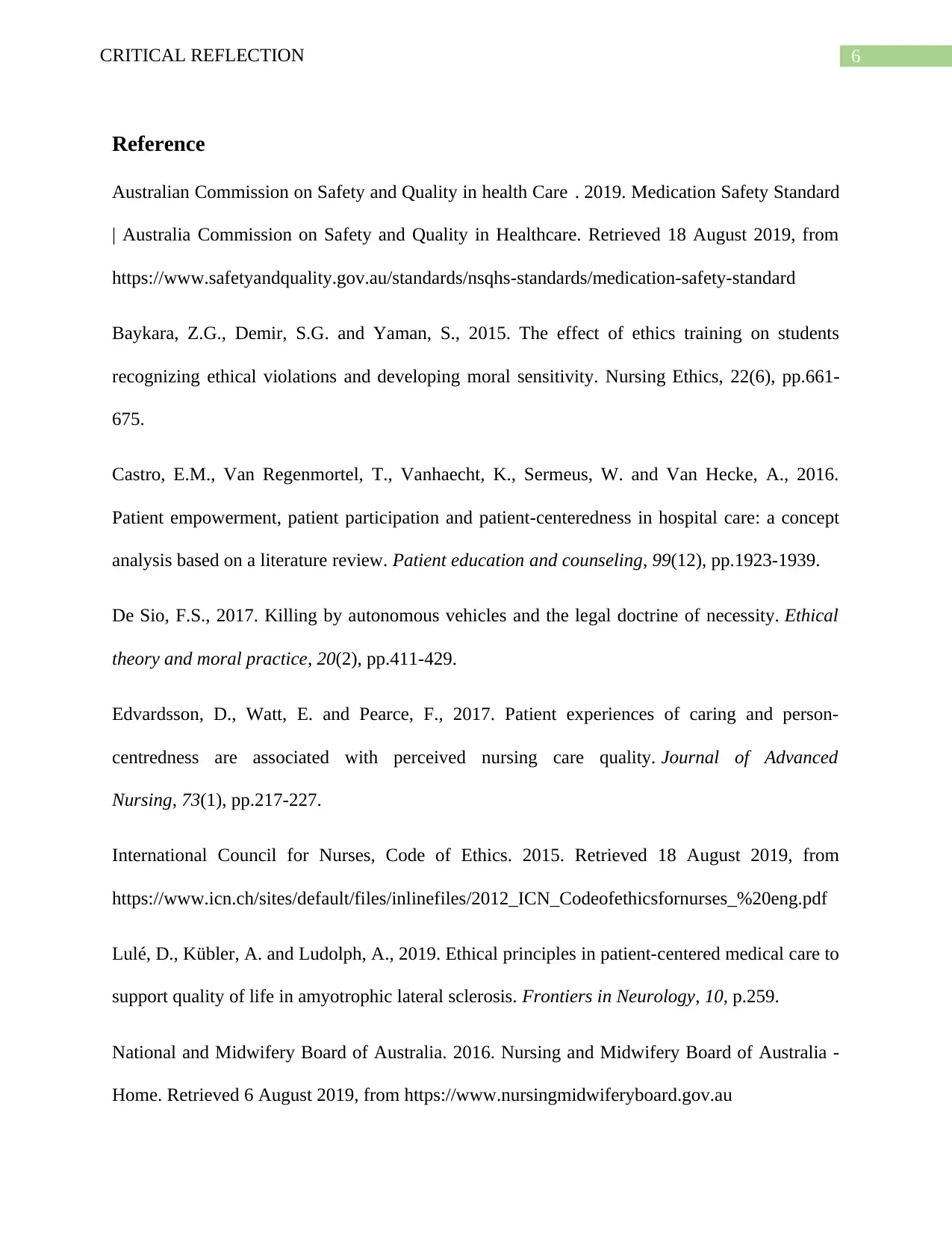
6CRITICAL REFLECTION
Reference
Australian Commission on Safety and Quality in health Care . 2019. Medication Safety Standard
| Australia Commission on Safety and Quality in Healthcare. Retrieved 18 August 2019, from
https://www.safetyandquality.gov.au/standards/nsqhs-standards/medication-safety-standard
Baykara, Z.G., Demir, S.G. and Yaman, S., 2015. The effect of ethics training on students
recognizing ethical violations and developing moral sensitivity. Nursing Ethics, 22(6), pp.661-
675.
Castro, E.M., Van Regenmortel, T., Vanhaecht, K., Sermeus, W. and Van Hecke, A., 2016.
Patient empowerment, patient participation and patient-centeredness in hospital care: a concept
analysis based on a literature review. Patient education and counseling, 99(12), pp.1923-1939.
De Sio, F.S., 2017. Killing by autonomous vehicles and the legal doctrine of necessity. Ethical
theory and moral practice, 20(2), pp.411-429.
Edvardsson, D., Watt, E. and Pearce, F., 2017. Patient experiences of caring and person‐
centredness are associated with perceived nursing care quality. Journal of Advanced
Nursing, 73(1), pp.217-227.
International Council for Nurses, Code of Ethics. 2015. Retrieved 18 August 2019, from
https://www.icn.ch/sites/default/files/inlinefiles/2012_ICN_Codeofethicsfornurses_%20eng.pdf
Lulé, D., Kübler, A. and Ludolph, A., 2019. Ethical principles in patient-centered medical care to
support quality of life in amyotrophic lateral sclerosis. Frontiers in Neurology, 10, p.259.
National and Midwifery Board of Australia. 2016. Nursing and Midwifery Board of Australia -
Home. Retrieved 6 August 2019, from https://www.nursingmidwiferyboard.gov.au
Reference
Australian Commission on Safety and Quality in health Care . 2019. Medication Safety Standard
| Australia Commission on Safety and Quality in Healthcare. Retrieved 18 August 2019, from
https://www.safetyandquality.gov.au/standards/nsqhs-standards/medication-safety-standard
Baykara, Z.G., Demir, S.G. and Yaman, S., 2015. The effect of ethics training on students
recognizing ethical violations and developing moral sensitivity. Nursing Ethics, 22(6), pp.661-
675.
Castro, E.M., Van Regenmortel, T., Vanhaecht, K., Sermeus, W. and Van Hecke, A., 2016.
Patient empowerment, patient participation and patient-centeredness in hospital care: a concept
analysis based on a literature review. Patient education and counseling, 99(12), pp.1923-1939.
De Sio, F.S., 2017. Killing by autonomous vehicles and the legal doctrine of necessity. Ethical
theory and moral practice, 20(2), pp.411-429.
Edvardsson, D., Watt, E. and Pearce, F., 2017. Patient experiences of caring and person‐
centredness are associated with perceived nursing care quality. Journal of Advanced
Nursing, 73(1), pp.217-227.
International Council for Nurses, Code of Ethics. 2015. Retrieved 18 August 2019, from
https://www.icn.ch/sites/default/files/inlinefiles/2012_ICN_Codeofethicsfornurses_%20eng.pdf
Lulé, D., Kübler, A. and Ludolph, A., 2019. Ethical principles in patient-centered medical care to
support quality of life in amyotrophic lateral sclerosis. Frontiers in Neurology, 10, p.259.
National and Midwifery Board of Australia. 2016. Nursing and Midwifery Board of Australia -
Home. Retrieved 6 August 2019, from https://www.nursingmidwiferyboard.gov.au
Paraphrase This Document
Need a fresh take? Get an instant paraphrase of this document with our AI Paraphraser
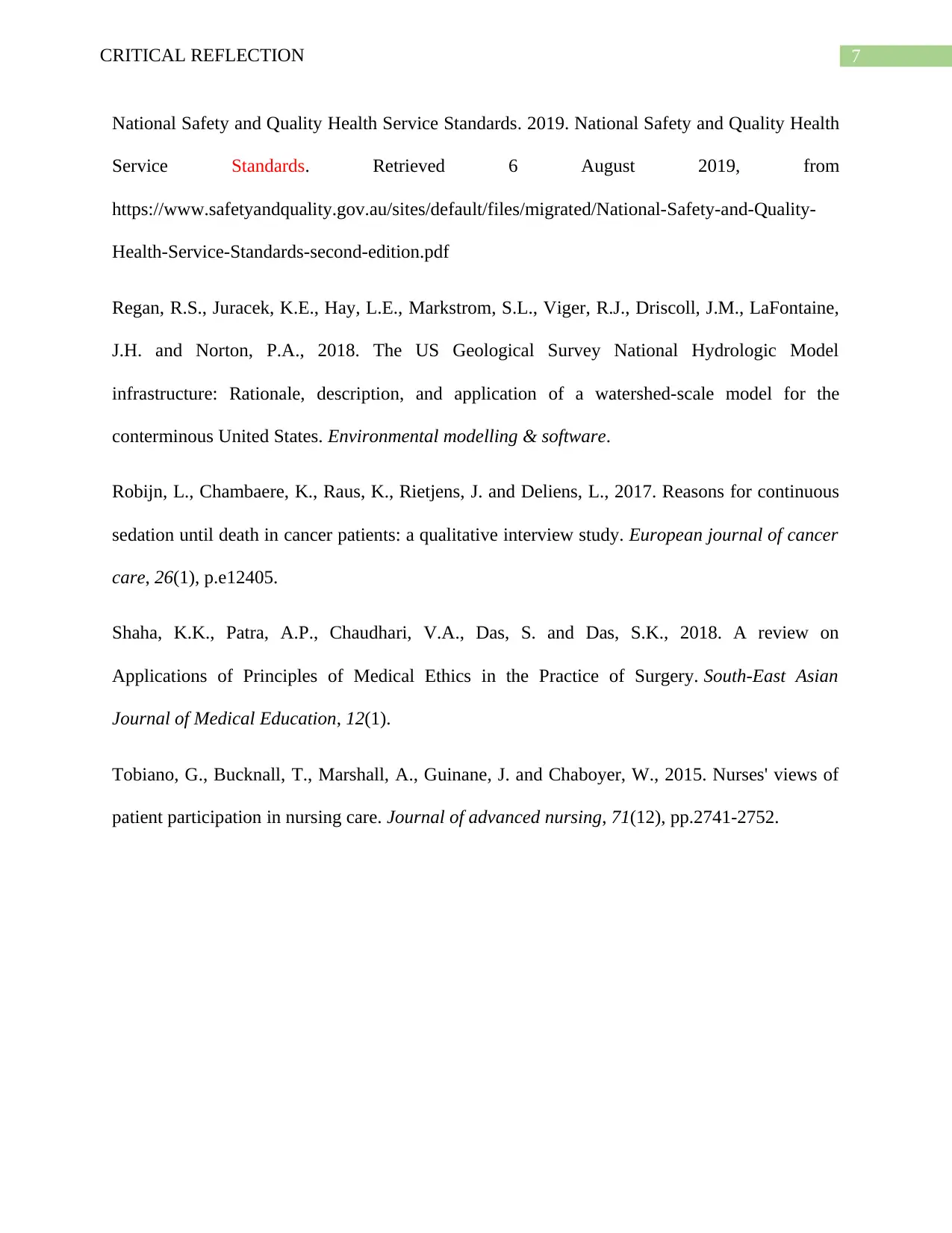
7CRITICAL REFLECTION
National Safety and Quality Health Service Standards. 2019. National Safety and Quality Health
Service Standards. Retrieved 6 August 2019, from
https://www.safetyandquality.gov.au/sites/default/files/migrated/National-Safety-and-Quality-
Health-Service-Standards-second-edition.pdf
Regan, R.S., Juracek, K.E., Hay, L.E., Markstrom, S.L., Viger, R.J., Driscoll, J.M., LaFontaine,
J.H. and Norton, P.A., 2018. The US Geological Survey National Hydrologic Model
infrastructure: Rationale, description, and application of a watershed-scale model for the
conterminous United States. Environmental modelling & software.
Robijn, L., Chambaere, K., Raus, K., Rietjens, J. and Deliens, L., 2017. Reasons for continuous
sedation until death in cancer patients: a qualitative interview study. European journal of cancer
care, 26(1), p.e12405.
Shaha, K.K., Patra, A.P., Chaudhari, V.A., Das, S. and Das, S.K., 2018. A review on
Applications of Principles of Medical Ethics in the Practice of Surgery. South-East Asian
Journal of Medical Education, 12(1).
Tobiano, G., Bucknall, T., Marshall, A., Guinane, J. and Chaboyer, W., 2015. Nurses' views of
patient participation in nursing care. Journal of advanced nursing, 71(12), pp.2741-2752.
National Safety and Quality Health Service Standards. 2019. National Safety and Quality Health
Service Standards. Retrieved 6 August 2019, from
https://www.safetyandquality.gov.au/sites/default/files/migrated/National-Safety-and-Quality-
Health-Service-Standards-second-edition.pdf
Regan, R.S., Juracek, K.E., Hay, L.E., Markstrom, S.L., Viger, R.J., Driscoll, J.M., LaFontaine,
J.H. and Norton, P.A., 2018. The US Geological Survey National Hydrologic Model
infrastructure: Rationale, description, and application of a watershed-scale model for the
conterminous United States. Environmental modelling & software.
Robijn, L., Chambaere, K., Raus, K., Rietjens, J. and Deliens, L., 2017. Reasons for continuous
sedation until death in cancer patients: a qualitative interview study. European journal of cancer
care, 26(1), p.e12405.
Shaha, K.K., Patra, A.P., Chaudhari, V.A., Das, S. and Das, S.K., 2018. A review on
Applications of Principles of Medical Ethics in the Practice of Surgery. South-East Asian
Journal of Medical Education, 12(1).
Tobiano, G., Bucknall, T., Marshall, A., Guinane, J. and Chaboyer, W., 2015. Nurses' views of
patient participation in nursing care. Journal of advanced nursing, 71(12), pp.2741-2752.
1 out of 8
Related Documents
Your All-in-One AI-Powered Toolkit for Academic Success.
+13062052269
info@desklib.com
Available 24*7 on WhatsApp / Email
![[object Object]](/_next/static/media/star-bottom.7253800d.svg)
Unlock your academic potential
Copyright © 2020–2025 A2Z Services. All Rights Reserved. Developed and managed by ZUCOL.





